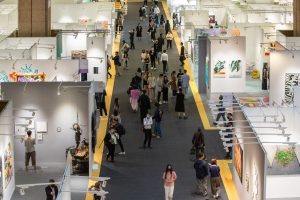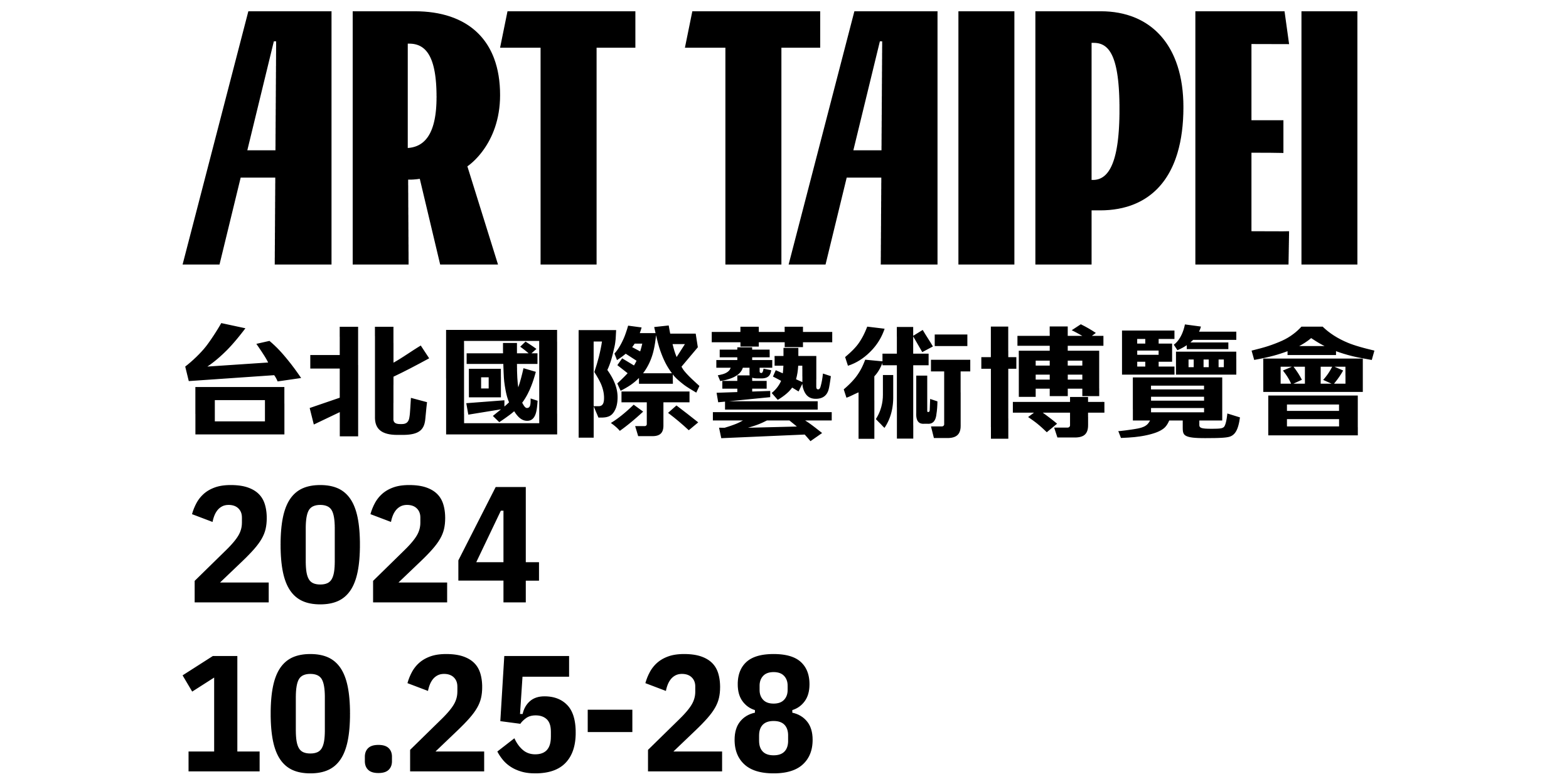
A view of ART TAIPEI 2022 Image/©ART TAIPEI
By Xao-E
As the sequence of time gently ushers in autumn, not only are all major international auction houses gearing up for their grand annual sales extravaganza, but one of the oldest art fairs in Asia, ART TAIPEI, is also set to celebrate in grand style from October 19th to 23rd. Collectors from home and abroad will gather to commemorate its illustrious 30-year history. In the midst of the bustling stage about to be set by the primary and secondary art markets, one may ponder: What is the current state of the art collecting world today?"
The global art market has shown signs of fatigue since the end of last year, after reaching a peak before the pandemic. This is a reality that most collectors clearly recognize. The main reason is the skyrocketing prices of artworks and related fees, which have caused many experienced collectors to hesitate. Even though market chaos is no stranger to the realm of art collection, the recent years have seen an absurd atmosphere of speculation surrounding emerging artists in the secondary market. This frenzy has resulted in a massive stockpile of works held by speculators, inflicting serious damage to the overall art market.
The following outlines several noteworthy phenomena in the contemporary art market since the end of 2022:
I. The vitality of the art market has suffered a profound impact over the past year.

A view of Art Cologne. (photograph courtesy of Art Cologne)
Although secondary market data may not always reflect the overall sales performance of the art market, it is a good indicator of the market's downstream heat, and is highly relevant. This is supported by many of the recently released Artnet Intelligence Report, Mid-Year Review 2023 findings.
First, according to the report summary, the trading volume of the pure art market in major secondary markets decreased by 14% between January and May 20, 2023, compared to the same period last year (with a possible error of about one month).The sales of the ultra-contemporary art (Ultra-contemporary art refers to works created by artists born after 1974) block decreased by 25% year-on-year. The sales of the three major international auction houses, Sotheby's, Christie's, and Phillips, in the first half of the year decreased by a full 22%. Furthermore, the total trading volume of works in the million-dollar block even sharply decreased by 51%, presenting a bleak scene of the international art market this year. When we consider the actual sales results of auction companies in New York, London, Paris, Hong Kong, and even Taiwan at the beginning of 2023, as well as feedback from industry insiders at the 2023 Taipei Dangdai Art, it mutually confirm the fact that the market is receding.
II. The mass production of artworks has caused serious visual fatigue, leading to poor market sales.
In the past, the stock market usually had a positive correlation with the sales of artworks when it was at high stock market levels, such as the market’s crazy surge before the 2008 financial crisis. Conversely, when the stock market is not doing well, it significantly affects the willingness to purchase and collect artworks, as exemplified by the global stock market downturn from 2015 to 2016. Based on this logic, the poor performance of the art market this year should be affected by the overall economic downturn. However, in the stock market, the Dow Jones Industrial Average, the Nasdaq Composite Index, and the Taiwan Stock Exchange reached all-time highs in July. This market surge was caused by the government's reckless spending to save the market during the pandemic, and people poured money into the art market in the hope of getting rich quickly. As a result, the art market's disorderly behavior from 2020 to the first half of 2022 almost reached its historical peak.
Regular international auction houses traditionally had an unwritten rule to refuse most works created or resold at auction within the past four years. This rule was largely broken during the pandemic. Looking at the proportion of lots in major auction companies that are jokingly referred to as “paintings not yet dry,” they often account for 10% to 15% of many special sessions. This has led to vicious competition between galleries and emerging artists. Everyone is deeply afraid of missing this crazy money-making opportunity, so a large number of popular and counterfeit works that lack substance but are eye-catching have emerged, causing serious visual and aesthetic fatigue.
These mediocre works with mere semblances fail to appeal to capable collectors who are more focused on intrinsic value than speculation. On the other hand, other non-speculative works also fail to attract the younger generation of collectors, whose aesthetic and values differ from those of previous generations. The author believes that the simultaneous occurrence of these two situations is the primary reason for the subdued enthusiasm and significant contraction in trading volume in the art market over the past year.
III. The primary and secondary markets are recklessly creating markets, causing artists' market cycles to shorten rapidly.

Jordy Kerwick solo exhibition ”Année du Tigre, L'heure du Tigre” at WOAW Gallery. Image/©WOAW Gallery
Starting from the year 2020, when the pandemic emerged, galleries have found themselves under immense competitive pressure. Alongside emerging artists (many of whom are young, though not exclusively), they have often whimsically cultivated the secondary market. Obscure artists' works, previously unknown, frequently soared to unprecedented heights during their first auction or within a short span of time. Their values multiplied severalfold, becoming a new norm. Yet, the meteoric rises were often short-lived, and these once-market darlings swiftly transformed into toxic collectibles shunned by all. Even artists of undeniable talent were not spared, as the speculative fervor of the market led to rapid declines in secondary market prices. Artists like Jordy Kerwick, who was manipulated by speculators just last year, and many artists discussed in this article, such as Anna Weyant, Lauren Quin, Julien Nguyen, Issy Wood, Lucy Bull, Maria Berrio, Scott Kahn, and Caroline Walker, all saw their momentum decline after a surge at the beginning. After one or two seasons, market buying interest has clearly shown signs of fatigue.
In the past, it was often a cycle of 3 to 5 years. This acceptable cycle has gradually shortened to about 3 years. Now, it is already very impressive for the artist to survive for more than two seasons. Such an unhealthy market situation is indeed worrying. However, in the case that the market has already shrunk and the buying interest is no longer supported it, the group of speculators may also learn a lesson, thereby driving lousymoney out of the market and giving the collection ecology a chance to return to normal.
Despite the rather unoptimistic market performance, there is still ample opportunity in the final four months of this year to carefully examine potential developments. This examination may serve as the foundation for reharmonizing the pace of one's art collection.
I. The next one to two years will be a transformation period for the art market to settle down a little.
Due to the significant losses suffered by market speculators in the previous period, the situation of speculation on emerging artists has been somewhat restrained this year. In particular, it is no longer common to see hammer prices more than ten times higher in New York and London day auctions. Even in the New Now emerging art auction that is well-known in the industry, the turnover rate has also decreased significantly compared to the pandemic period. In the future, both galleries and the secondary market may enter a period of consolidation. The art market is expected to temporarily shift towards a collection-oriented atmosphere until the next generation gap of collectors appears in 5 to 10 years, bringing new market trends.
II. The potential resurgence of abstract painting into the mainstream of Western collections has grown.

Mark Rothko, ”No. 14, 1960” ,1960, oil painting, SFMOMA collection. Image/©Peter E
Abstract painting, compared to figurative painting, is an incredibly arduous endeavor. Beyond the relatively nebulous benchmarks, artists must navigate towards a unique "formula" that embodies their personal style. Once entering the market, they must simultaneously garner recognition from collectors, art critics, and the academic sphere, a formidable ordeal indeed. Even for luminaries like Gerhard Richter and Mark Rothko, who are considered at the pinnacle, their abstract works, upon prolonged scrutiny, struggle to escape the trappings of formulaic repetition, often receiving critique. Moreover, the market is inundated with a multitude of uninspired "mediocre abstractions."
Figurative art has always held the largest share in the Chinese art market. Since 2018, these figurative works have also become mainstream in the international market, enjoying popularity for almost six years. However, the proliferation of poor quality and imitation figurative paintings in recent years has become unbearable. Eventually, this might inversely form a force to bring abstract works back to the international market. After all, prior to the end of 2017, abstract works once dominated most Western art markets for approximately five years. Perhaps more abstract paintings will return to the market from next year.
III. The rediscovery and refinement of the market for esteemed and seasoned artists.

Liu Yiqian and Wang Wei’s collection of Léonard Tsuguharu Foujita’s
"Nude with Cat" (1930) is set to be auctioned at the end of the year.
Image/©Sotheby’s Hong Kong
Considering the potential moderation in speculative enthusiasm for emerging artists after the pandemic, mid-career and established artists, who have not yet reached their peak prices, may regain collectors' attention. This conjecture is rooted in the notion that certain works manufactured en masse by contemporary and super-contemporary artists have reached unimaginable prices in the primary market. For those artists who, though not inexpensive, possess exceptional essence and distinctiveness, such as Neo Rauch, Takesada Matsutani, Léonard Tsuguharu Foujita, and Pierre Soulages, among others, one can anticipate their future market developments. Furthermore, the gradually maturing domestic contemporary art market in China, as indicated by the aforementioned Artnet report, appears to show signs of resurgence (with transaction volumes rising by 10% compared to the same period last year). Adopting a prudent and discerning approach remains advisable, making it a market worthy of further observation.
The response of Taiwan's primary art market is relatively gradual and tempered when contrasted with the international market's reactions. In past editions of ART TAIPEI, there has been an abundance of trendy works that skewed the collector's desire, leading to fluctuations in buying enthusiasm and visual fatigue. However, it is evident that Taiwanese collectors are gradually shifting towards a more rational style of collecting. This year's ART TAIPEI undoubtedly serves as the highly anticipated year-end examination for Taiwan's contemporary visual art market.
